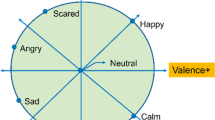Abstract
Most studies use the facial expression to recognize a user’s emotion; however, gestures, such as nodding, shaking the head, or stillness can also be indicators of the user’s emotion. In our research, we use the facial expression and gestures to detect and recognize a user’s emotion. The pervasive Microsoft Kinect sensor captures video data, from which several features representing facial expressions and gestures are extracted. An in-house extensible markup language-based genetic programming engine (XGP) evolves the emotion recognition module of our system. To improve the computational performance of the recognition module, we implemented and compared several approaches, including directed evolution, collaborative filtering via canonical voting, and a genetic algorithm, for an automated voting system. The experimental results indicate that XGP is feasible for evolving emotion classifiers. In addition, the obtained results verify that collaborative filtering improves the generality of recognition. From a psychological viewpoint, the results prove that different people might express their emotions differently, as the emotion classifiers that are evolved for particular users might not be applied successfully to other user(s).







Similar content being viewed by others
References
Pentland A (2008) Honest signals. MIT press, Cambridge
Picard RW (1997) Affective computing. MIT Media Laboratory Perceptual Computing Section Technical Report No. 321
Picard RW (2010) Affective computing: from laughter to IEEE. IEEE Trans Affect Comput 1(1):11–17
Ekman P (2003) Emotions revealed. Times Books, New York, USA
Ekman P, Friesen WV (1977) Facial action coding system. Consulting Psychologist Press, Palo Alto
Takahashi K (2009) Remarks on computational emotion recognition and expression. In: 6th international symposium on image and signal processing and analysis
Russel JA (1980) A circumplex model of affect. J Personal Soc Psychol 1980(39):1161–1178
Plutchik R (2001) The nature of emotions. Am Sci 89(4):344. doi:10.1511/2001.4.344
Yusuf R et al (2014) Designing evolving computer agent capable of emotion recognition and expression. AAAI Spring Symposium, Palo Alto
Yusuf R, Tanev I, Shimohara K (2014) Evolving emotion recognition module for intelligent agent. In: 18th Asia Pacific symposium on intelligent and evolutionary systems, Singapore, pp 215–226
Ahlberg J (2001) CANDIDE 3—an updated parameterized face. Report no. LiTH-ISY-R-2326, Dept. of Electrical Engineering, Linköping University, Sweden
Tanev I, Shimohara K (2010) XML-based genetic programming framework: design philosophy, implementation, and applications. Artif-Life Robot 15(4):376–380
Tanev I, Shimohara K (2007) XGP: XML-based genetic programming framework. In: Proceedings of the 34th symposium of the society of instrument and control engineers (SICE) on intelligent systems, Japan, pp 183–188
Yusuf R et al (2015) Evolving emotion recognition module of intelligent agent based on facial expression and gestures. In: 20th international symposium on artificial life and robotics, Japan, pp 227–232
Author information
Authors and Affiliations
Corresponding author
About this article
Cite this article
Yusuf, R., Sharma, D.G., Tanev, I. et al. Evolving an emotion recognition module for an intelligent agent using genetic programming and a genetic algorithm. Artif Life Robotics 21, 85–90 (2016). https://doi.org/10.1007/s10015-016-0263-z
Received:
Accepted:
Published:
Issue Date:
DOI: https://doi.org/10.1007/s10015-016-0263-z




